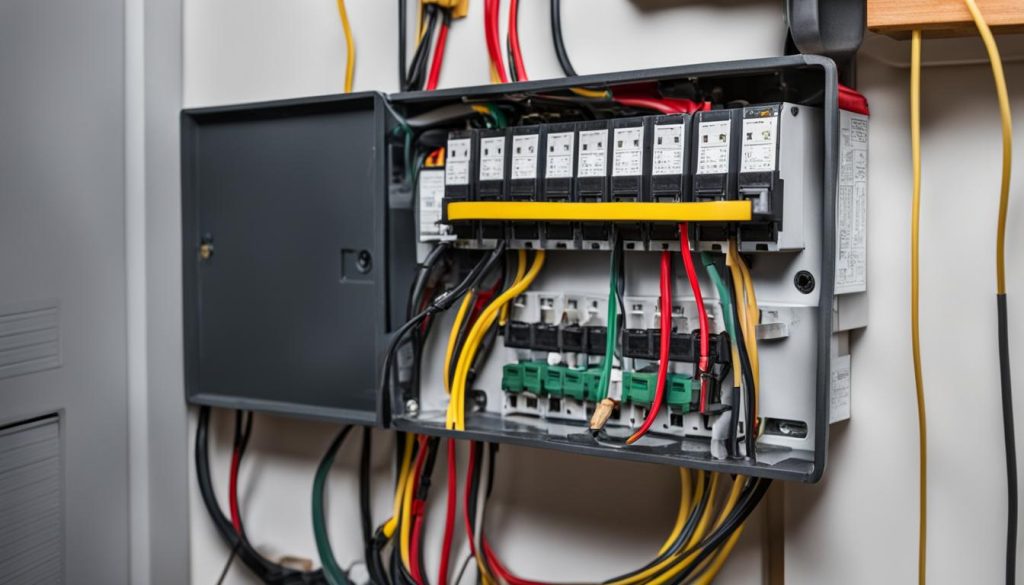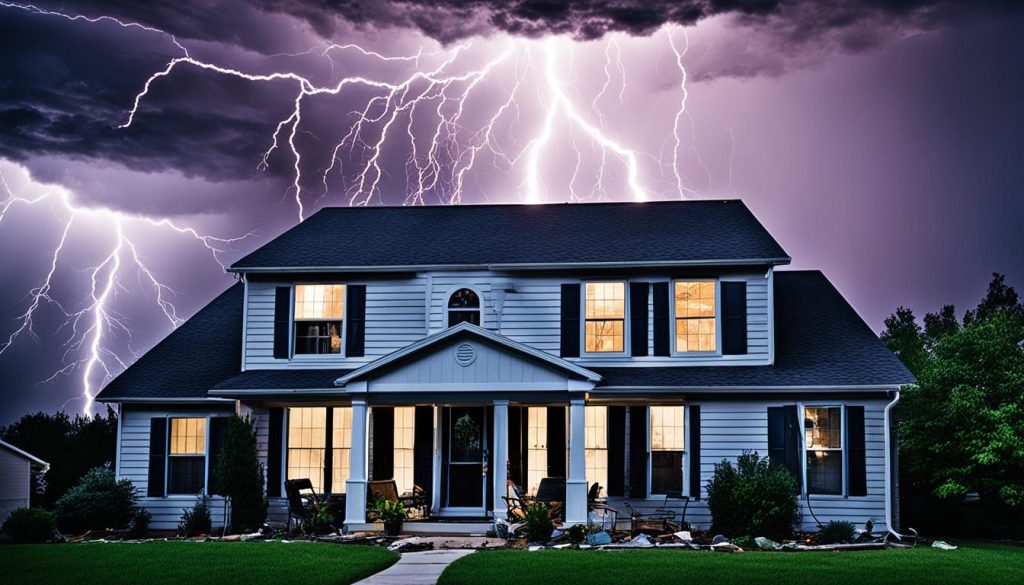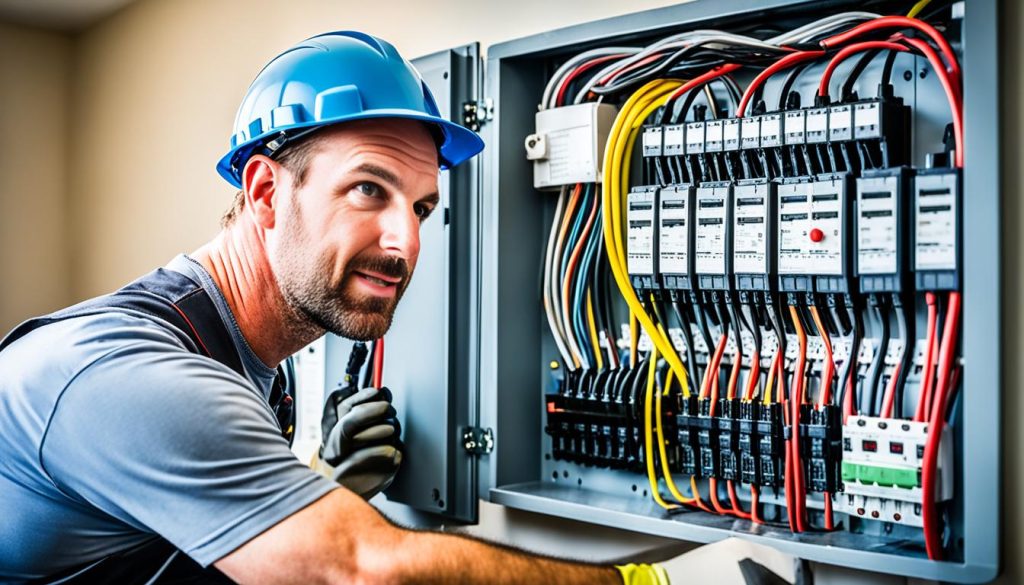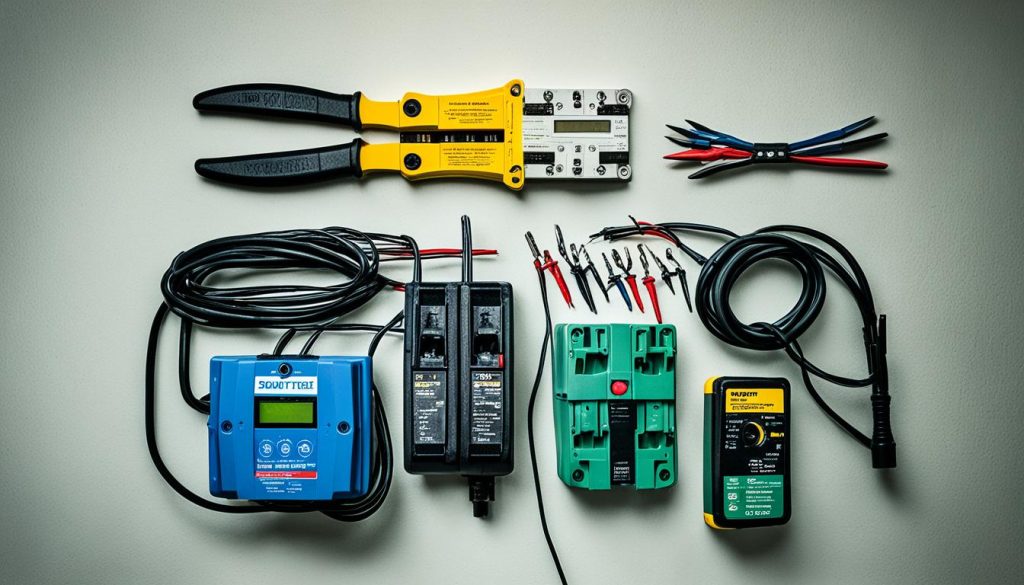Protecting your home’s electrical system and appliances is essential, especially when it comes to power surges. Power surges can occur unexpectedly due to various factors, such as lightning strikes, downed power lines, increased electrical demand, or faulty wiring. These surges can cause extensive damage to your devices and appliances, leading to costly repairs or replacements.
Installing a whole-house surge protector is a proactive step in safeguarding your home and ensuring the longevity of your electrical system. By having a surge protector installed, you can effectively divert excessive voltage away from your devices and appliances, preventing potential damage caused by power surges.
Key Takeaways:
- Power surges can cause significant damage to your devices and appliances.
- Installing a whole-house surge protector is crucial for protecting your home’s electrical system.
- A surge protector helps divert excessive voltage away from your devices, preventing damage.
- Power surges can occur due to various factors, including lightning strikes and faulty wiring.
- By investing in whole-house surge protection, you can save money in the long run by avoiding costly repairs or replacements.
Types of Surge Protection Devices
When it comes to protecting your home’s electrical system and appliances from power surges, there are two main types of surge protection devices to consider: Type 1 and Type 2.
Type 1 Surge Protectors:
These surge protectors are meter-based devices that are installed outside on the electrical meter of your home. They provide the first line of defense against power surges and are designed to intercept high-voltage surges before they enter your home’s electrical panel. Type 1 surge protectors are typically recommended in areas with a higher risk of lightning strikes or frequent power surges.
Type 2 Surge Protectors:
These surge protectors, on the other hand, are panel-based devices that are installed inside on the main electrical panel of your home. They provide additional protection against power surges and are designed to suppress lower-level surges that may still reach your electrical panel. Type 2 surge protectors are suitable for most residential applications and offer reliable surge protection for your home’s electrical system and appliances.
- Selecting the right type of surge protector depends on your specific needs and the recommendations of a licensed electrician.
- Type 1 devices require professional installation due to their placement on the electrical meter.
- Type 2 devices can be installed by skilled homeowners following proper guidelines, but it is always recommended to consult with a licensed electrician to ensure safety and optimal performance.
Protecting your home with the right surge protection device can save you from costly damage and ensure the longevity of your electrical system. Stay tuned for the next section, where we will discuss the necessary tools and materials required for whole house surge protector installation.
Necessary Tools and Materials
Before installing a whole-house surge protector, you will need a set of tools and materials. Having the right equipment is crucial for a successful installation process and ensures the safety and efficiency of your home’s electrical system.
Here is a list of the necessary tools and materials:
- Personal protective equipment (PPE): Insulated work boots, electrical safety gloves, and eye protection are essential to protect yourself from electrical hazards during the installation process.
- Non-contact voltage tester: This tool helps you determine if electrical circuits are live or not, ensuring your safety while working.
- Double-pole circuit breaker: You will need a circuit breaker rated for your surge protector to connect it to your electrical panel.
- Cable clamp: The cable clamp secures the wires in place and prevents them from being accidentally pulled or damaged.
- Screwdriver or power drill: These tools are necessary for removing and attaching electrical panels or covers.
- Wire strippers: Wire strippers are used to remove the insulation from the wires, allowing for proper connections.
- Hammer and nail punch (or pliers): These tools are useful for mounting the surge protector and making holes if needed in the electrical panel.
- The surge protector: Choose a high-quality whole-house surge protector that meets your home’s needs and offers reliable surge protection for all your electrical devices and appliances.
Ensuring that you have all the necessary tools and materials on hand before starting the installation process will help you complete the task efficiently and safely. Remember to follow the manufacturer’s instructions and consult a licensed electrician if you have any doubts or concerns.
Tools and Materials for Whole House Surge Protector Installation
| Tool/Equipment | Description |
|---|---|
| Personal protective equipment (PPE) | Insulated work boots, electrical safety gloves, and eye protection |
| Non-contact voltage tester | To determine live circuits |
| Double-pole circuit breaker | Rated for the surge protector |
| Cable clamp | Secures wires in place |
| Screwdriver or power drill | For removing and attaching panels/covers |
| Wire strippers | To remove insulation from wires |
| Hammer and nail punch (or pliers) | Mounting the surge protector and making holes if needed |
| The surge protector | High-quality device for whole-house surge protection |
Step-by-Step Installation Guide
Installing a whole-house surge protector is a straightforward process that can be done by following these step-by-step instructions. Ensure your safety by wearing personal protective equipment such as insulated work boots, electrical safety gloves, and eye protection.
- Turn off the main power supply to your home by flipping the main circuit breaker in your electrical panel.
- Identify the appropriate location for your surge protector. This is usually near the main electrical panel or close to where the power lines enter your home.
- Mount the surge protector securely to the wall using the provided screws or brackets.
- Attach the surge protector to the main electrical panel by connecting the hot wire to the breaker on the panel. Use a cable clamp to secure the wire in place.
- Strip the insulation from the end of the wire and connect it to the surge protector using the appropriate terminal or connection method specified in the manufacturer’s instructions.
- Test the wiring using a non-contact voltage tester to ensure no electricity is present.
- Restore power to your home by flipping the main circuit breaker back on.
- Verify that the surge protector is functioning correctly by using a surge protector tester or consulting with a licensed electrician.
It is important to note that this installation guide provides a general overview of the installation process. Always refer to the manufacturer’s instructions and consult with a licensed electrician for specific guidance related to your home’s electrical system.
Remember, safety should always be your top priority when working with electrical systems. If you are unsure or uncomfortable with any of the installation steps, it is best to hire a professional electrician to perform the installation for you.

Benefits of Whole-House Surge Protection
Installing a whole-house surge protector offers several benefits. It provides comprehensive protection for all your electronics and appliances, reducing the risk of damage caused by power surges. Additionally, it helps prevent electrical fires by diverting excessive voltage away from sensitive devices.
- Protects all your electronics and appliances from power surges
- Reduces the risk of damage to your devices
- Prevents electrical fires by diverting excessive voltage
By investing in whole-house surge protection, you can save money in the long run by protecting your expensive electronics and appliances from potential damage. Furthermore, having whole-house surge protection increases the resale value of your home, providing an additional selling point for potential buyers.
“Installing a whole-house surge protector is like having an insurance policy for your electronics and appliances. It gives you peace of mind knowing that your devices are protected against costly damage caused by power surges.” – Mark Johnson, Licensed Electrician
Protect your home, your devices, and your investment by opting for whole-house surge protection. It’s a smart decision that ensures the longevity and performance of your electrical system while keeping your family safe.

Importance of Professional Installation
While it is possible for skilled homeowners to install a Type 2 surge protector themselves, it is highly recommended to hire a licensed electrician for professional installation. Working with electrical systems can be dangerous, and a professional electrician has the knowledge and experience to ensure a safe and proper installation. They can also provide guidance in selecting the right surge protector for your specific needs and address any potential wiring issues. Professional installation ensures that the surge protector is correctly installed and reduces the risk of electrical hazards.

Why Professional Installation is Essential
Electrical safety should always be a top priority when it comes to installing a whole-house surge protector. Hiring a licensed electrician guarantees a high level of expertise and adherence to safety standards. They have the necessary training and experience to handle complex electrical systems without compromising safety. Trying to install a surge protector without professional assistance can lead to mistakes that may result in electrical malfunctions, fire hazards, or even personal injury.
“When it comes to electrical installations, it’s crucial to prioritize safety. Hiring a professional electrician ensures that the whole-house surge protector is installed correctly, minimizing the risk of electrical hazards.” – John Johnson, Licensed Electrician
Guidance in Choosing the Right Surge Protector
Professional electricians have in-depth knowledge of surge protectors and can assist you in selecting the right one for your specific needs. They will consider factors such as your home’s electrical capacity, the types of appliances you have, and the potential risks in your area. By analyzing these factors, they can recommend a surge protector model that provides optimal protection for your entire home.
- Assistance in selecting the right Type 2 surge protector based on your electrical system and requirements
- Knowledge of surge protector brands and models to ensure the highest level of protection
- Expertise in assessing potential wiring issues and making necessary adjustments
The Benefits of Professional Installation
By opting for professional installation of your whole-house surge protector, you can enjoy the following benefits:
- Peace of mind knowing that the surge protector is installed correctly, reducing the risk of electrical damage
- Enhanced electrical safety for your home and family
- Longer lifespan for your electrical appliances and devices
- Minimized risk of electrical fires and hazards
Ensure the safety and efficiency of your whole-house surge protector installation by entrusting the job to a qualified electrician. Their expertise and experience are invaluable in safeguarding your home’s electrical system and providing you with peace of mind.
DIY Risks and When to Hire a Professional
When it comes to whole house surge protector installation, it’s important to consider the risks associated with DIY projects. Working with your home’s electrical system can be dangerous, especially if you lack prior experience in this area. Interfering with the primary power supply without the necessary knowledge and skills can lead to serious hazards like electrocution or electrical fires.
That’s why it is highly recommended to hire a professional electrician for the installation of a surge protector. A licensed electrician has the expertise to ensure the safety and proper functioning of the surge protector. They understand the intricacies of electrical systems and will ensure that the installation is done correctly, minimizing the risk of electrical hazards.
While DIY projects can be appealing for cost-saving reasons, the potential dangers involved make it worth investing in professional installation. The cost of hiring a professional electrician is a small price to pay for the peace of mind and protection it provides for your home and electrical system.
If you’re unsure whether to tackle the installation yourself or hire a professional, consider the complexity and nature of the project. If you have experience working with electrical systems and feel confident in your abilities, you may be able to install a Type 2 surge protector following proper guidelines. However, if you have little to no experience or are uncertain about any aspect of the installation process, it’s best to leave it to the experts.
Remember, the safety of your home and family should always be the top priority. By hiring a professional electrician, you can ensure that the whole-house surge protector is installed safely and efficiently, providing optimal surge protection for your electrical system.

Benefits of Hiring a Professional Electrician:
- Expertise and knowledge in electrical systems
- Safe and proper installation of the surge protector
- Minimization of electrical hazards
- Peace of mind and protection for your home
DIY installation of a whole-house surge protector carries certain risks, especially for those without prior experience in working with electrical systems. Interfering with the primary power supply can be dangerous and can lead to electrocution or other hazards. It is always recommended to hire a professional electrician for the installation of a surge protector to ensure safety and proper functioning. The cost of professional installation is well worth the peace of mind and protection it provides for your home and electrical system.
Conclusion
Installing a whole-house surge protector is a critical step in ensuring the safety and longevity of your home’s electrical system. By safeguarding against power surges, you can protect your appliances and electronic devices from potential damage and reduce the risk of electrical fires.
Comprehensive surge protection not only provides peace of mind but also offers long-term savings. With a whole-house surge protector in place, you can avoid costly repairs or replacement of expensive equipment due to power surge-related damage.
While Type 2 surge protectors can be installed by skilled homeowners, it is highly recommended to hire a professional electrician for the installation process. Their expertise and knowledge will ensure a safe and optimal installation, addressing any potential wiring issues along the way.
Investing in whole-house surge protection and opting for professional installation will help secure the well-being of your electrical system, protecting it from unexpected power surges and providing you with a secure and worry-free home environment.
FAQ
Why is installing a whole-house surge protector important?
Installing a whole-house surge protector is crucial for protecting your home’s electrical system and appliances from power surges. Power surges can cause significant damage to your devices and appliances, and a surge protector helps safeguard your home and ensure the longevity of your electrical system.
What are the types of surge protection devices?
There are two types of surge protection devices: Type 1 and Type 2. Type 1 surge protectors are meter-based and installed outside on the electrical meter. Type 2 surge protectors are panel-based and installed inside on the main electrical panel of your home. Type 1 devices require professional installation, while Type 2 devices can be installed by skilled homeowners following proper guidelines.
What tools and materials do I need for whole-house surge protector installation?
Before installing a whole-house surge protector, you will need personal protective equipment (insulated work boots, electrical safety gloves, and eye protection), a non-contact voltage tester, a double-pole circuit breaker rated for your surge protector, a cable clamp, a screwdriver or power drill, wire strippers, a hammer, nail punch or pliers, and the surge protector itself.
How do I install a whole-house surge protector?
Follow this step-by-step guide for installing a whole-house surge protector:
What are the benefits of whole-house surge protection?
Whole-house surge protection provides comprehensive protection for all your electronics and appliances, reducing the risk of damage caused by power surges. It helps prevent electrical fires by diverting excessive voltage away from sensitive devices. By investing in whole-house surge protection, you can protect your expensive electronics and appliances from potential damage and increase the resale value of your home.
Why is professional installation important for whole-house surge protectors?
Working with electrical systems can be dangerous, and a professional electrician has the knowledge and experience to ensure a safe and proper installation. They can provide guidance in selecting the right surge protector for your needs and address any potential wiring issues. Professional installation ensures the surge protector is correctly installed and reduces the risk of electrical hazards.
Are there risks to DIY installation of a whole-house surge protector?
Yes, DIY installation carries certain risks, especially for those without prior experience in working with electrical systems. Interfering with the primary power supply can be dangerous and can lead to electrocution or other hazards. It is always recommended to hire a professional electrician for the installation of a surge protector to ensure safety and proper functioning.
How much does professional installation of a whole-house surge protector cost?
The cost of professional installation varies depending on factors such as the type of surge protector, complexity of the electrical system, and location. It is best to consult with a licensed electrician for an accurate cost estimate.


